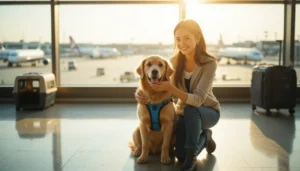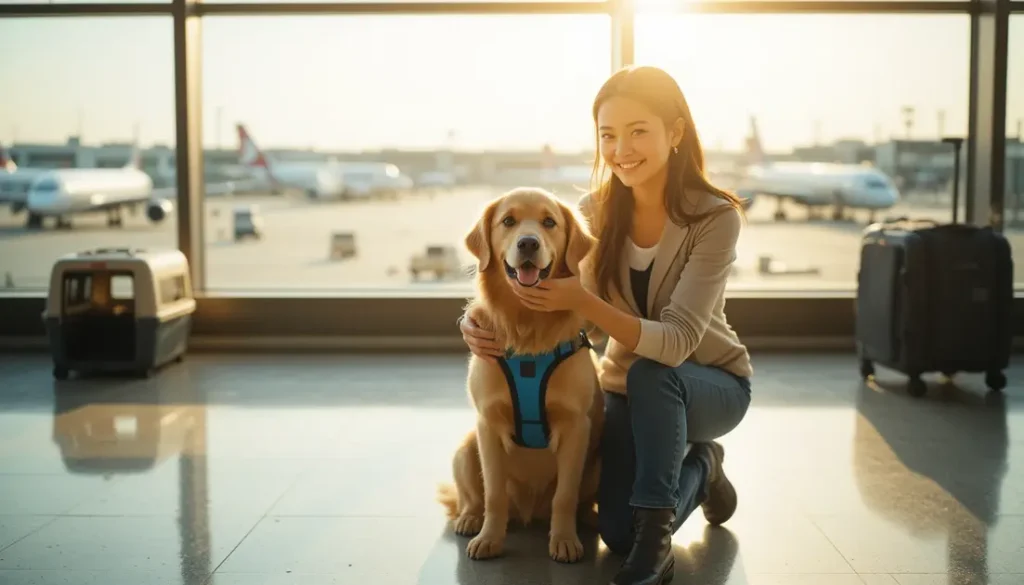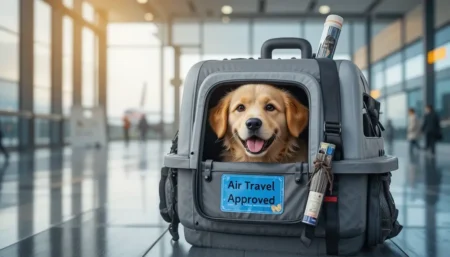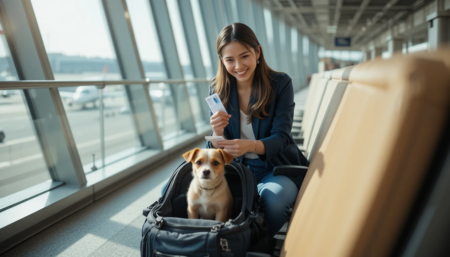Pet travel insurance benefits include emergency veterinary coverage, trip cancellation protection, and reimbursement for travel delays caused by pet illness. It ensures your companion receives urgent care anywhere while protecting you from unexpected costs that can exceed thousands of dollars during domestic or international trips.
This guide breaks down real benefits, coverage comparisons, and expert-backed tips to help you choose the right policy for stress-free adventures with your pet.
Why Standard Pet Insurance Falls Short When You Travel
Your regular pet insurance policy might leave you exposed the moment you cross state lines or board an international flight. Most domestic pet insurance plans operate within network restrictions that shrink dramatically outside your home region.
Some policies exclude coverage entirely for incidents occurring more than 100 miles from your primary residence. Others require you to pay overseas vet bills upfront and navigate complex reimbursement processes that can take months.
Travel-specific policies eliminate these gaps. They’re engineered for mobility, recognizing that a dog who eats something suspicious in Paris or a cat who develops respiratory distress during a Texas road trip needs immediate, guaranteed care.
The benefits extend beyond simple vet bills—they protect the financial investment of your entire trip and provide logistical support when you’re far from home.

7 Core Pet Travel Insurance Benefits That Protect Every Trip
1. Emergency Veterinary Coverage Across Borders
This benefit pays for unexpected illness or injury treatment at any licensed veterinary clinic worldwide, without network restrictions.
Unlike standard plans that might categorize out-of-area care as “out-of-network” with reduced reimbursement, travel policies cover 80-100% of costs up to your chosen limit, typically $5,000 to $10,000 per trip.
Why this matters: A single emergency vet visit in Europe averages €800-€1,500 ($850-$1,600). Surgery for issues like foreign body ingestion can cost €3,000-€5,000. Travel insurance ensures you never hesitate to seek care because of cost concerns.
Expert tip from veterinary travelers: Dr. Melissa Grant, who practices in three countries, notes that “many foreign clinics require payment before treatment. Travel insurance with direct-pay capabilities removes the panic of transferring large sums during a crisis.”
2. Trip Cancellation and Interruption Protection
If your pet develops a covered illness or injury before departure, this benefit reimburses non-refundable travel expenses—flights, hotels, tours—up to policy limits. Coverage typically ranges from $2,000 to $5,000 per trip.
The problem it solves: You’ve spent $3,000 on a non-refundable beach rental. Two days before departure, your dog tears a cruciate ligament and requires immediate surgery. Standard pet insurance covers the surgery, but not your lost vacation investment. Travel insurance covers both.
Real-world application: Policies distinguish between pre-existing conditions (not covered) and new acute issues. Document your pet’s health before booking a vet exam and keep records to streamline claims.
3. Travel Delay Reimbursement
When a pet emergency extends your stay unexpectedly, this benefit covers additional accommodation, meals, and local transportation costs. Limits typically run $100-150 per day for up to 5-7 days.
Why you need it: Your cat develops a urinary blockage requiring 48-hour hospitalization in Denver, forcing you to miss your flight home. Instead of paying $200/night for a last-minute hotel while waiting for clearance to fly, your policy absorbs those costs.
Key detail: Benefits usually trigger after a minimum delay period—often 12-24 hours—to prevent abuse for minor issues.
4. Lost or Delayed Pet Document Coverage
International travel requires exact documentation: health certificates, vaccination records, and microchip verification. If these are lost, stolen, or delayed, this benefit pays for expedited replacements, translation services, and even re-boarding fees. Coverage averages $500-1,000 per occurrence.
The hidden value: Replacing an international health certificate abroad can cost $300-500 and take 2-3 days. Some countries require official translations at $50-100 per page. This benefit ensures bureaucratic snafus don’t strand you or force you to leave your pet behind.
5. Emergency Boarding and Kennel Fees
If you’re hospitalized during travel and cannot care for your pet, this benefit covers licensed kennel or pet-sitting fees. Coverage typically provides $50-75 per day for up to 7-10 days.
Critical distinction: This activates for your medical emergency, not your pet’s. If you contract severe food poisoning in Bangkok and require 72 hours of hospitalization, your dog’s stay at a local boarding facility gets covered.
Pro tip: Verify the policy defines “hospitalization” as inpatient admission—ER visits alone may not qualify.
6. Liability Coverage for Pet-Related Incidents
When traveling, your homeowner’s or renter’s liability coverage may not extend to incidents involving your pet. This benefit covers property damage or injury your pet causes to third parties, typically up to $100,000.
Why it’s overlooked but vital: Your dog startles a cyclist on a shared trail, causing a crash with €5,000 in medical bills. Your home policy might deny the claim because it occurred 2,000 miles away. Travel liability coverage steps in immediately.
Expert insight: Animal behaviorist Dr. Tom Barrett advises that “travel stress can alter pet behavior unpredictably. Even well-trained animals may bite, scratch, or bolt in unfamiliar environments. Liability coverage is non-negotiable for international trips.”
7. Repatriation and Emergency Transport
In worst-case scenarios—pet death or need for specialized treatment unavailable locally—this benefit covers the cost of returning your pet home or transporting them to appropriate facilities. Coverage limits range from $1,500 to unlimited, depending on the policy.
When this matters: Your dog develops a rare condition requiring a specialist not available in rural Costa Rica. The policy arranges and pays for air transport to Miami or back to your home city.
Important caveat: Most policies require pre-approval for repatriation except in immediately life-threatening situations where delay would cause suffering.
Data Insight: Pet Travel Insurance Claim Patterns
Before you plan your next trip, it helps to know what pet travel insurance could cover. This snapshot summarizes key claim types, costs, and trends using example data.
Claim Cost Overview
Emergency Vet Treatment Abroad: $1,850 average
Trip Cancellation for One Pet: $2,340 typical reimbursement
Travel Delay Expenses (2–3 days): $420 average
Claim Behavior Trends
Most Frequent Issue: Gastrointestinal illness (34%)
Highest Claim Reviewed: $8,900 (emergency surgery + extended travel delay)
Pet Size Influence: Large dogs (50+ lbs) show a 22% increase in average claim amounts
Seasonal Pattern: Claim frequency rises by approximately 40% during the summer months
How Pet Travel Insurance Differs from Standard Policies
Understanding the distinction helps you avoid double-paying or leaving critical gaps.
Geographic Freedom: Standard policies often limit coverage to your home country or require notification for travel. Travel policies provide seamless global coverage.
Coverage Speed: Travel insurance emphasizes rapid reimbursement—often within 5-7 business days—to accommodate travelers on tight schedules. Standard pet insurance may take 30+ days.
Benefit Breadth: While standard policies focus exclusively on medical costs, travel insurance bundles logistical protections—trip cancellation, delays, document replacement—that standard policies never address.
Pre-Existing Conditions: Both types exclude pre-existing conditions, but travel policies often have shorter look-back periods (6-12 months vs. 12-18 months for standard plans).
Cost Structure: Travel policies charge per trip or offer annual multi-trip plans. Standard policies charge monthly premiums regardless of travel frequency.
The overlap question: Should you cancel your standard policy when buying travel coverage? No. Travel insurance functions as a specialized supplement. Maintain your standard policy for routine care at home and use travel insurance for trips. Some insurers now bundle both, offering a base policy with travel rider add-ons.

Real Scenarios Where Benefits Prove Essential
Scenario 1: The Alpine Emergency
You’re hiking in the Swiss Alps with your Labrador when she cuts her paw on sharp rocks. The local vet requires €1,200 for stitches, antibiotics, and a follow-up visit.
Your travel insurance directly pays the clinic, and the travel delay coverage pays for your extra two nights in a mountain lodge ($180/night) while she recovers enough to fly home.
Scenario 2: The Pre-Trip Diagnosis
Three days before your Caribbean cruise, your cat shows signs of feline infectious peritonitis. The vet recommends immediate treatment and advises against travel.
Your trip cancellation benefit reimburses the $4,500 non-refundable cruise fare, while your standard pet insurance (if you have it) covers the treatment costs.
Scenario 3: The Documentation Disaster
Arriving in Australia, customs discovers your dog’s rabies titer documentation is incomplete. You’re denied entry and must book immediate return flights.
Your policy covers the $800 replacement documentation process, $1,500 in rebooking fees, and a night at an airport hotel.
Scenario 4: The Multi-Pet Complexity
Traveling with two dogs, one develops severe kennel cough requiring isolation. Your policy covers his veterinary care and, under the delay benefit, covers boarding for both dogs separately (to prevent transmission) plus your extended hotel stay.

Choosing the Right Policy: Key Comparison Factors
Trip Duration and Frequency
- Single-trip policies: Cover one journey up to 180 days. Ideal for annual vacations.
- Annual multi-trip: Covers unlimited trips within a year, each up to 30-90 days. Cost-effective for frequent travelers.
- Extended stay: Specialized policies for relocations or snowbird lifestyles lasting 6+ months.
Destination-Specific Requirements
Travel to EU countries, the UK, Australia, or New Zealand involves stringent entry requirements. Verify your policy explicitly covers:
- Post-arrival health checks
- Quarantine cost reimbursement if entry is denied
- Document translation services
- Third-party liability meeting local minimums (some countries require €150,000+)
C. Species and Breed Considerations
- Dogs: Most policies cover all breeds, but some exclude “restricted breeds” for liability coverage in certain countries.
- Cats: Generally easier to insure; fewer breed restrictions.
- Exotic pets: Birds, reptiles, and rabbits require specialized policies. Standard travel plans exclude them.
Coverage Limits and Deductibles
Compare policies using this framework:
| Coverage Type | Basic Plan | Premium Plan |
|---|---|---|
| Emergency Vet | $5,000 | $10,000 |
| Trip Cancellation | $2,500 | $5,000 |
| Travel Delay (per day) | $100 (5 days max) | $150 (7 days max) |
| Liability | $50,000 | $100,000 |
| Deductible | $250 | $100 |
The sweet spot: Most pet owners benefit from mid-tier plans offering $7,500 vet coverage and $100,000 liability. High-deductible plans ($500+) rarely make sense for travel, where costs escalate quickly.
Direct Pay vs. Reimbursement
Direct pay: Insurance pays the vet directly. Requires a policy partnership with the clinic but eliminates your out-of-pocket burden. More common with premium plans.
Reimbursement: You pay upfront, file a claim, and receive payment. Takes longer but works at any licensed clinic. Ensure the policy offers at least 80% reimbursement.
Cost vs. Benefit Analysis: Is It Worth It?
Price Ranges (2025 Estimates)
- Single-trip domestic: $30-60 for 7 days
- Single-trip international: $80-150 for 14 days
- Annual multi-trip: $200-400 per year
Break-Even Math
A policy costing $125 for a two-week European vacation breaks even if it prevents just one $625 expense (assuming 80% reimbursement with a $100 deductible). Given that the average international emergency vet visit exceeds $1,500, the math favors insurance.
Risk assessment framework: Consider your pet’s age, health, destination, and trip cost. The formula:
- Pets over 7 years old: Add 30% to claim probability
- Brachycephalic breeds (pugs, bulldogs): Add 25% due to respiratory risks
- Adventure travel (hiking, camping): Add 40%
- International destinations: Add 20% for documentation issues
Example calculation: A 9-year-old pug traveling to Italy for a hiking trip carries an elevated risk across three categories. The $150 policy premium likely represents good value compared to the potential $3,000+ exposure.
When It May Not Make Sense
- Domestic weekend trips, where your standard pet insurance provides adequate out-of-area coverage
- Travel to a location with known, low-cost veterinary care, and you have ample emergency savings
- Trips under $500 total investment where self-insuring is feasible

Expert Tips for Maximizing Your Coverage
Pre-Travel Preparation
- Schedule a pre-trip vet exam 10-14 days before departure. This creates a health baseline and ensures all documentation is current. Most policies require this for coverage activation.
- Register your microchip with an international database. If lost abroad, recovery depends on traceable information. Some policies offer microchip registration as a free add-on.
- Photograph everything: Your pet, documents, carrier, and any pre-existing conditions. Visual proof accelerates claims and prevents disputes.
During Travel
- Keep a physical and digital copy of your policy. Store the insurer’s 24/7 helpline in your phone and wallet. Emergency assistance services can direct you to approved clinics worldwide.
- Use the insurer’s vet locator service. Many partner with networks like VetFinder Global, which pre-screens clinics for quality and English-speaking staff.
- Report incidents within 24 hours. Delayed reporting can void coverage. Even if you’re unsure whether a problem will escalate, file a preliminary claim.
Claims Strategy
- Bundle related expenses. A single incident (e.g., pet illness) may trigger multiple benefits—vet care, travel delay, document replacement. File one comprehensive claim referencing all applicable coverage sections.
- Negotiate with providers. Some foreign vets charge “tourist rates.” Ask your insurer to intervene; they often have pre-negotiated rates that can reduce your bill by 20-30% before coverage even applies.
Policy Shopping Wisdom
- Look for “cancel for any reason” add-ons. While 30-40% more expensive, these allow you to recoup 50-75% of trip costs even if you cancel due to pet anxiety or non-medical issues.
- Check credit card benefits first. Some premium travel cards offer basic pet travel protection. While insufficient alone, they can supplement a dedicated policy.
Common Exclusions Every Owner Must Understand
Pre-existing conditions: Any condition diagnosed or showing symptoms in the 6-12 months before policy purchase is excluded. This includes chronic issues like allergies or past injuries.
Routine care: Vaccinations, flea treatments, and wellness exams aren’t covered. Travel insurance responds to emergencies, not maintenance.
High-risk activities: Injuries sustained during competitive sports (agility trials, hunting) or extreme adventure (mountain climbing with your dog) may be excluded unless you purchase a sports rider.
Breed-specific exclusions: Some policies exclude hereditary conditions common to purebreds—like hip dysplasia in German shepherds—unless you purchase enhanced coverage.
Destination restrictions: Travel to countries with CDC “do not travel” advisories or active disease outbreaks may void coverage. Check your policy’s country blacklist.
Age limits: Most policies won’t cover pets under 8 weeks or over 14 years. Some insurers offer senior pet riders extending coverage to 16 years with reduced limits.
Negligence: If you leave your pet unattended in a vehicle or fail to follow airline crate requirements, claims will be denied. Policies require reasonable care standards.
Final Thoughts: Making the Smart Choice
Pet travel insurance transforms uncertainty into manageable risk. The benefits extend far beyond simple vet bill coverage, protecting your entire travel investment and providing critical logistical support when you’re vulnerable in an unfamiliar place.
For most pet owners, the cost of a policy represents less than 5% of total trip expenses while shielding against losses that can reach 200% of those same expenses.
The key is matching policy features to your specific situation—destination, pet health, trip cost, and travel style. Don’t overpay for benefits you’ll never use, but never skimp on liability limits or emergency vet coverage.
The difference between a $5,000 and $10,000 vet limit often costs just $20-30 more per trip, but could save you from devastating financial choices during a crisis.
Before your next adventure, take 30 minutes to compare three policies using the comparison framework above. Read the full exclusion list, not just the marketing highlights. Your pet deserves protection that works as hard as you do to give them amazing experiences.








